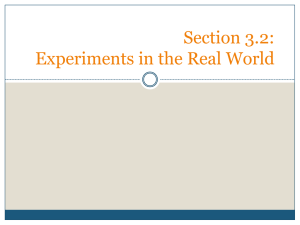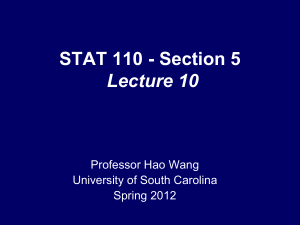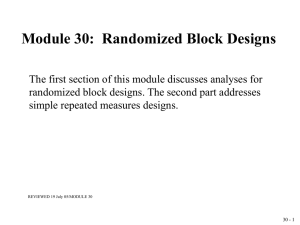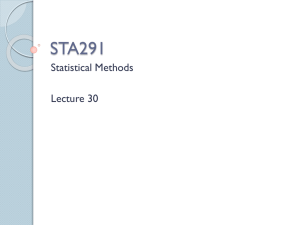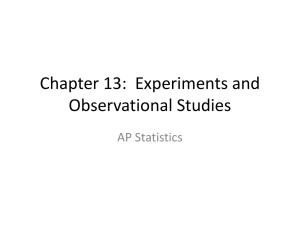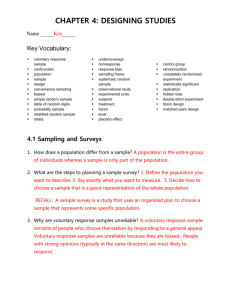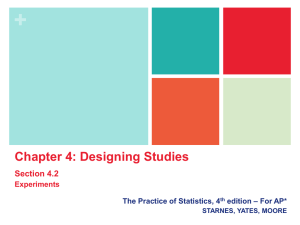Chap 9
advertisement
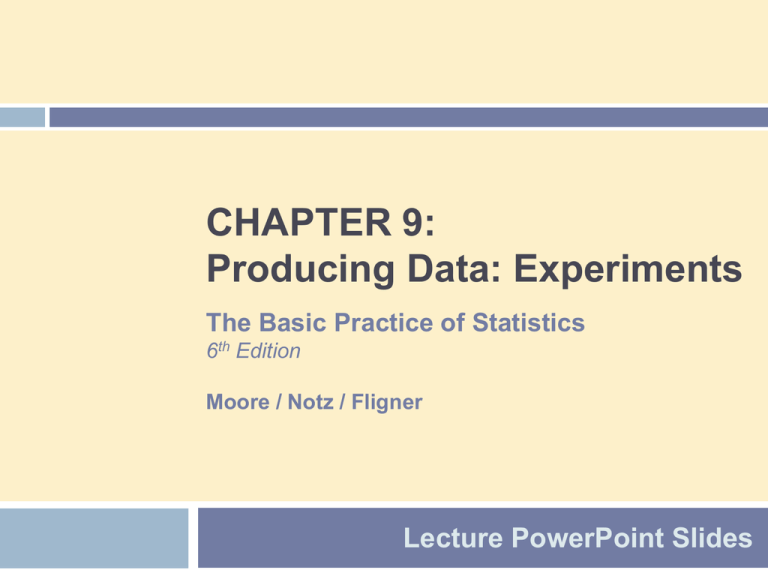
CHAPTER 9: Producing Data: Experiments The Basic Practice of Statistics 6th Edition Moore / Notz / Fligner Lecture PowerPoint Slides Chapter 9 Concepts 2 Observation vs. Experiment Subjects, Factors, Treatments How to Experiment Badly Randomized Comparative Experiments Cautions About Experimentation Matched Pairs and Other Block Designs Chapter 9 Objectives 3 Distinguish between observations and experiments Identify subjects, factors, and treatments Describe how to experiment badly Design randomized comparative experiments Describe cautions about experimentation Describe matched pairs and other block designs Observation vs. Experiment In contrast to observational studies, experiments don’t just observe individuals or ask them questions. They actively impose some treatment in order to measure the response. An observational study observes individuals and measures variables of interest but does not attempt to influence the responses. The purpose is to describe some group or situation. An experiment deliberately imposes some treatment on individuals to measure their responses. The purpose is to study whether the treatment causes a change in the response. When our goal is to understand cause and effect, experiments are the only source of fully convincing data. The distinction between observational study and experiment is one of the most important in statistics. Confounding 5 Observational studies of the effect of one variable on another often fail because of confounding between the explanatory variable and one or more lurking variables. A lurking variable is a variable that is not among the explanatory or response variables in a study but that may influence the response variable. Confounding occurs when two variables are associated in such a way that their effects on a response variable cannot be distinguished from each other. Well-designed experiments take steps to avoid confounding. Individuals, Factors, Treatments 6 An experiment is a statistical study in which we actually do something (a treatment) to people, animals, or objects (the experimental units) to observe the response. Here is the basic vocabulary of experiments. The experimental units are the smallest collection of individuals to which treatments are applied. When the units are human beings, they often are called subjects. The explanatory variables in an experiment are often called factors. A specific condition applied to the individuals in an experiment is called a treatment. If an experiment has several explanatory variables, a treatment is a combination of specific values of these variables. How to Experiment Badly 7 Experiments are the preferred method for examining the effect of one variable on another. By imposing the specific treatment of interest and controlling other influences, we can pin down cause and effect. Good designs are essential for effective experiments, just as they are for sampling. A high school regularly offers a review course to prepare students for the SAT. This year, budget cuts will allow the school to offer only an online version of the course. Students Online Course SAT Scores Over the past 10 years, the average SAT score of students in the classroom course was 1620. The online group gets an average score of 1780. That’s roughly 10% higher than the long-time average for those who took the classroom review course. Is the online course more effective? How to Experiment Badly 8 Many laboratory experiments use a design like the one in the online SAT course example: Experimental Units In the laboratory environment, simple designs often work well. Field experiments and experiments with animals or people deal with more variable conditions. Outside the laboratory, badly designed experiments often yield worthless results because of confounding. Randomized Comparative Experiments 9 The remedy for confounding is to perform a comparative experiment in which some units receive one treatment and similar units receive another. Most well-designed experiments compare two or more treatments. Comparison alone isn’t enough. If the treatments are given to groups that differ greatly, bias will result. The solution to the problem of bias is random assignment. In an experiment, random assignment means that experimental units are assigned to treatments at random, that is, using some sort of chance process. Randomized Comparative Experiments 10 In a completely randomized design, the treatments are assigned to all the experimental units completely by chance. Some experiments may include a control group that receives an inactive treatment or an existing baseline treatment. Group 1 Experimental Units Random Assignment Group 2 The Logic of Randomized Comparative Designs 11 Randomized comparative experiments are designed to give good evidence that differences in the treatments actually cause the differences we see in the response. Principles of Experimental Design 1. Control for lurking variables that might affect the response, most simply by comparing two or more treatments. 2. Randomize: Use chance to assign experimental units to treatments. 3. Replication: Use enough experimental units in each group to reduce chance variation in the results. An observed effect so large that it would rarely occur by chance is called statistically significant. A statistically significant association in data from a well-designed experiment does imply causation. Cautions About Experimentation 12 The logic of a randomized comparative experiment depends on our ability to treat all the subjects the same in every way except for the actual treatments being compared. In a double-blind experiment, neither the subjects nor those who interact with them and measure the response variable know which treatment a subject received. Blocked Designs 13 Completely randomized designs are the simplest statistical designs for experiments. But just as with sampling, there are times when the simplest method doesn’t yield the most precise results. A block is a group of experimental units that are known before the experiment to be similar in some way that is expected to affect the response to the treatments. In a block design, the random assignment of experimental units to treatments is carried out separately within each block. Form blocks based on the most important unavoidable sources of variability (lurking variables) among the experimental units. Randomization will average out the effects of the remaining lurking variables and allow an unbiased comparison of the treatments. Control what you can, block on what you can’t control, and randomize to create comparable groups. Matched Pairs 14 A common type of randomized block design for comparing two treatments is a matched pairs design. The idea is to create blocks by matching pairs of similar experimental units. A matched-pairs design is a randomized blocked experiment in which each block consists of a matching pair of similar experimental units. Chance is used to determine which unit in each pair gets each treatment. Sometimes, a “pair” in a matched-pairs design consists of a single unit that receives both treatments. Since the order of the treatments can influence the response, chance is used to determine which treatment is applied first for each unit. Chapter 9 Objectives Review 15 Distinguish between observations and experiments Identify subjects, factors, and treatments Describe how to experiment badly Design randomized comparative experiments Describe cautions about experimentation Describe matched pairs and other block designs


